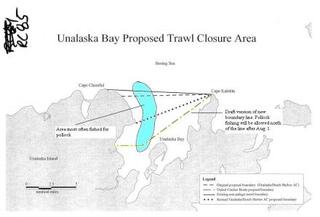Unalaska Bay trawl closure compromise passes

Tuesday, February 09 2010
Unalaska, AK – The proposed Unalaska Bay trawl closure passed and failed in parts at the Board of Fisheries meeting in Anchorage last week. The proposal called for all of Unalaska Bay, the area south of a line from Cape Cheerful to Kalekta, to be closed to all trawling year-round. Currently the area is open during pollock B' season, from June 10 until November 1. Residents say the area should be reserved for subsistence and sport fishing for the community. Some say they have gear conflicts with the trawlers and have lost long lines and pots. Conversely, pollock fishermen say the area is important because it's a good source of local, high-quality pollock that can be fished without using much fuel.
Alaska Department of Fish & Game area management biologist Forrest Bowers said the Board decided to go with a pollock industry suggested compromise.
"The pollock industry proposed a different line running from Cape Kalekta down to the navigational buoy near Hog Island then over to Broad Bay. Then the original Unalaska line from Cape Kalekta to Cape Cheerful would be in effect from the beginning of the season on June 10 until August 1. Then after August 1 the pollock fishermen would be allowed to move down to that second line that I described."
The entire bay would be closed when people are fishing for sockeye salmon but would open again when people fish for cohos.
Bowers said that a majority of the salmon caught by the pollock boats is not local fish, and the bycatch doesn't affect local populations. The Board also did not see much formal evidence of gear conflicts, like reports to Fish & Game or NMFS, just anecdotes.
Icicle government affairs spokesperson Kris Norosz testified against the closure. She said that her company's skippers rely on the fish caught in Unalaska Bay. They get between five and 27 percent of their harvest in a canyon on the west side of Hog Island because they can get large fish that they can quickly deliver back to Icicle's fillet lines. She also testified about her company's fleet.
"Our vessels are generally small in comparison to other Bering Sea trawl vessels," she said. "They're limited more by weather conditions and associated safety concerns as well as they're limited by the speed of their vessels and that relates to product quality issues."
Norosz said that the area is not heavily fished, it just seems that way because of vessel traffic. "There are boats going in and out of there year round. And just because they're going in and out of there doesn't mean they are fishing that area. I think part of it is a perception problem. There's a lot of boats that go through there that are towing nets, that are washing them. Their cod ends are open and they aren't actually fishing."
The new closure area leaves open most of the canyon where pollock trawlers fish and closes most of the areas close to the community. The Department of Fish and Game is neutral on the issue, though they support the idea of reducing bycatch and gear conflicts in the Bay. The new closure rule will go into effect this year after it is signed into law by the Lt. Governor.
The Board of Fish also ruled on other proposals that affect local fishermen. One proposal applies to herring in Unalaska. Now, purse seine vessels can fish any left over gillnet allocations in the Dutch Harbor area starting on July 25. That gives gillnetters a month to pursue their allocation without any competition. This is the first time the allocation can switch over to the other gear type. In previous years, gillnetters have left about 200 tons of herring unharvested because there is a limited market for small quantities of herring. Purse seiners have a better market and can get the rest of the harvest.
Additionally, the Board decided to open areas near Adak to cod fishing for boats up to 125 feet. After August 1, larger boats will be allowed back into an area previously restricted to 60 feet and under. The larger boats can now try for some of the previously foregone harvest. Last year the smaller boats left 6 million pounds of cod in the water.



